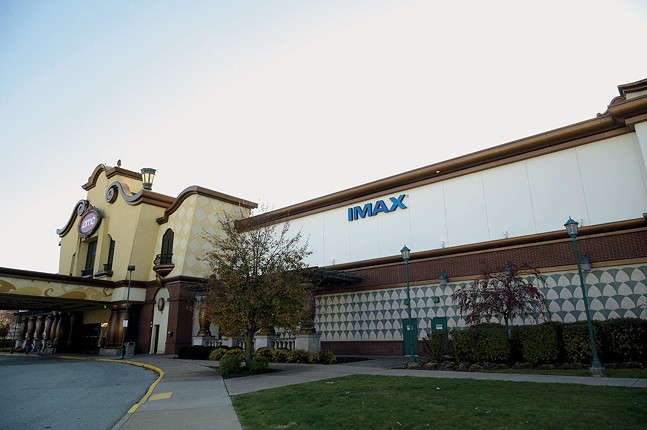The last weekend of April 2018, along with millions of other Americans, I piled into an IMAX theater to see Avengers: Infinity War. Though I consider myself to be a cinephile, I am not a Marvel Cinematic Universe fan — just a long-suffering MCU bride. But some of my favorite experiences have been at the movies (cue the Nicole Kidman AMC ad) and back then, with the MCU at the peak of its powers, I was swayed.
The theater at Pittsburgh Mills was packed for opening weekend, fans cheering and clapping when Iron Man or Star-Lord appeared and with every gratuitous needle drop, enthralled for the movie’s entire two-and-a-half-hour runtime. Infinity War was also the first Hollywood film shot entirely with IMAX cameras, and it was presented in an expanded aspect ratio, offering viewers an even larger image projected on the 52-by-72-foot IMAX screen.
Today, you can’t recreate my Infinity War experience. This is not only because of the MCU’s decline, but because Pittsburgh no longer has an actual IMAX theater. The last one, located at GQT Pittsburgh Mills Cinemas in Tarentum, sits hidden behind black pipe-and-drape curtains, non-operational and off limits to everyone but the theater’s employees.
Five years later, IMAX is still in the public conversation, most recently with the runaway success Oppenheimer approaching a billion-dollar box office. But you wouldn’t know it in Pittsburgh, our dead IMAX seemingly serving as a microcosm for the uncertain future of post-pandemic moviegoing in general.
So what happened to Pittsburgh’s IMAX? If there’s no IMAX, why is the brand plastered everywhere, including at the Waterfront AMC? Aren’t these distinctions just for film snobs? I submit that even for the uninitiated, not all film formats are created equal. Particularly in the era of streaming, we are losing something — beyond simple nostalgia — by phasing out our most spectacular theater experience, still championed by some of our most celebrated filmmakers. To get to the bottom of it (or process my grief: R.I.P. Old Pittsburgh), I looked into the history of the format and the fates of the region’s last three IMAX theaters.
The Rangos Giant Cinema at Carnegie Science Center
Since its founding, IMAX has been tied to science centers. Incorporated in 1967 by a group of Canadian filmmakers, the name IMAX is not an acronym but rather an inversion of the phrase “maximum image,” coined so that it could be copyrighted. IMAX refers not only to the size of the projection surface but a proprietary system — encompassing the large screen, high-resolution cameras, film, and projectors, as well as the theater’s construction with stadium seating to allow audiences to view the larger images.
IMAX Corporation’s cofounders envisioned the new film format expanding the medium’s possibility for visual impact, and it easily lent itself to sweeping vistas, wildlife films, and nature documentaries. Thus, some of the earliest IMAX installations were in science centers and planetariums.
Key to creating that visual impact is also the size of the film stock itself. IMAX uses a 70-millimeter film strip rather than the standard 35mm, producing taller aspect ratios and a visual area more than eight times larger. The actual film negative is so large that it must be run through IMAX projectors horizontally, assembled and placed onto a platter by a projectionist. Famously, director Christopher Nolan — IMAX’s biggest evangelist — shot Oppenheimer entirely on IMAX film, even working with Kodak to custom-engineer black-and-white IMAX film stock.
“If you see for the first time an IMAX pure-contact print from a negative projected on the screen, it’s like somebody is slapping you in the face,” Hoyte Van Hoytema, Oppenheimer’s cinematographer, told NPR. Asked if he was guilty of a kind of elitism about IMAX film, he replied, “In a way, yes, I’m very snobby, but I also think that … the proof is in the pudding. You know, you’re not doing it just for self-indulgence['s] sake. You're doing it because you’re trying to create the best experience possible to see it.”
At three hours, Oppenheimer was the longest-ever movie made for IMAX, and the resulting supersized film reel weighed 600 pounds and was 11 miles long. Images of the film’s sheer bulk were incorporated into its marketing as staff at the world’s IMAX theaters — many of them housed in science centers and museums — were shown pushing projectors to their breaking points.
Alas, there was no viral video of a gargantuan film strip being carted around at the Carnegie Science Center this summer. The Center renovated its Omnimax Theater — which projects onto a dome-shaped screen — in 2017 after 25 years. To send off the Omnimax, they held a 31-hour farewell movie marathon (though there’s still seemingly a lot of nostalgia among Pittsburghers about the dome itself, despite the Buhl Planetarium & Observatory remaining domed.)
The updated Rangos Cinema now has a 71-by 39-foot Certified Giant Screen — still a premium large format, and, the Center says, the largest screen in Western Pennsylvania — but not IMAX.
Along with switching to a flat screen, the theater also underwent a full film-to-digital conversion. Increasingly, moving to digital video rather than film, though hotly debated among film fans, is the direction of the industry, including for IMAX itself. In other words, the Science Center likely couldn’t have shown a film like Oppenheimer, in IMAX or on film.
Remembering the golden age, on the wall of Marcus Harshaw’s office hangs a film reel in a tin from the old Omnimax. Harshaw, the Science Center’s Senior Director of Museum Experiences, explains that their digital system allows them to operate more efficiently, sometimes inputting a full day of Rangos programming in advance, no projectionist needed.
As for showing first-run Hollywood movies in general (which the Center did initially), Harshaw says that, unlike a multiplex, the nonprofit museum has to consider how to best use its single screen to serve patrons. Aside from the higher costs, financial risk, and steeper contractual obligations of showing new releases, the films also don’t necessarily align as neatly with the Science Center’s goals.
“What we’ve done is we’ve focused on [our] mission. We’ve focused on connecting people and science,” Harshaw tells Pittsburgh City Paper.
The vision is rather an “integrated experience,” says Harshaw. “What we have that the other theaters don't have is we make the experience a full day. You come in here, you have a great time in the exhibits. You grab lunch in the cafe … go over [and] see the Titanic [exhibit], and then finish up with a Titanic film … You can build a whole day here with the whole family.”
Showing the more traditional fare of educational films and nature documentaries also serves the mission to get kids excited about science, and the films shown are often not available anywhere else. The Center also adds Hollywood classics to its line-up, which filmgoers seem to love — on the Saturday before Thanksgiving (also Light Up Night), an older audience was in stitches at a showing of Planes, Trains and Automobiles.
Harshaw and Senior Manager of Marketing Megan McKenzie also advise film fans not to count out what’s still the biggest screen in the region — though not IMAX, you’re getting a premium experience at the Rangos Giant Cinema, they say.
“Going to Ireland, that’s not the type of documentary you will find on Netflix,” says McKenzie, referring to one recently screened film.
IMAX with Laser (or LieMAX) at AMC Waterfront 22
If there’s no IMAX, what’s going on with the big blue letters on the side of the Waterfront AMC? Like much in the entertainment industry, it comes down to free market logic.
As IMAX has gone digital, it’s expanded its brand beyond custom-built theaters into traditional multiplexes, leading to some confusion — or, some would say, deception.
In 2008, the company introduced Digital IMAX, a lower-cost system using lower-resolution projectors. Theaters not wanting to be saddled with the cost of building the standard seven-story IMAX screen — or not wanting the loss of image quality to be as evident — retrofitted existing theaters or built smaller screens. However, the IMAX branding remained, with the company not distinguishing between the old-school IMAX experience and the new digital one in its marketing or ticket prices. Drawing ire from film buffs, the new theaters were labeled “LieMAX.”
The Waterfront AMC first retrofitted its LieMAX in 2009, in time to screen a rerelease of The Dark Knight. It’s recently been upgraded to IMAX with Laser, switching from a xenon to a laser projector (part of a larger AMC partnership).
Though it’s still probably the best theater in the region to see an IMAX movie (or merely the only game left in town), the LieMAX screen is noticeably smaller and the image quality worse. If you’ve been to a true IMAX, it’s hard to shake the feeling of being cheated.
To further complicate matters, AMC also houses a Dolby Cinema, another premium theater with a larger screen and proprietary Dolby sound (Rangos also uses Dolby surround sound).
The emergence of Dolby is part of what’s been called an arms race for every theater chain or audio/visual company to create its own premium experience — diluting IMAX market share after a nearly 60-year streak. Cinemark has XD, Regal Entertainment has RPX (Regal Premium Experience), and so on, with theater owners betting that following the advent of LieMAX, and theater goers largely wanting to stick to our local cinemas, we won’t be that discriminating.
GQT Pittsburgh Mills Cinemas
This brings us back to Pittsburgh Mills, the lost IMAX. In early 2021, GQT (Goodrich Quality Theaters), a Michigan-based theater chain, bought the theater from Cinemark in a rumored fire sale during pandemic closures. Cinemark departed with the IMAX equipment from Pittsburgh Mills, including the 72-foot IMAX screen, leaving only scaffolding and the once-full stadium seating.
When asked if the IMAX theater will ever return, GQT management told City Paper: “While we would love to have the IMAX back in operation and talks with the IMAX corporation have been ongoing, we have not yet come to an agreement that makes financial sense given the current economic climate coupled with the recent actors and writers strikes. Currently, we do not have an expected reopen date or plan in place for IMAX at the Pittsburgh Mills Cinemas … that said we are exploring all avenues to offer more screens in the future to be able to accommodate movies and special events such as Dune and various concerts.”
The company also confirmed they’re in discussions to build out a theater with their own premium large format, GDX.
When I started on my IMAX odyssey (spurred by the release of Taylor Swift: The Eras Tour, concert documentary which, as it turns out, wasn’t even filmed for IMAX), I assumed the answer I sought would arise from one of those perennial Pittsburgh questions: are we a big city or a small town? The metro area can support three professional sport teams, stadium tours, but not an IMAX?
But the truth is more prosaic: markets shift, brands change, and, as with most of our experiences, we still don’t know which way the collective winds are blowing after the onset of COVID. The continued upheaval of the film industry makes it that much more difficult to discern if a billion-dollar success like Oppenheimer is repeatable.
For now, if you want to make the trek to see Dune: Part Two in true IMAX format next year, the closest theaters are in Columbus, Ohio and Chantilly, Va. Otherwise, you'll have to settle for the Waterfront — and its slightly inferior screen.



















